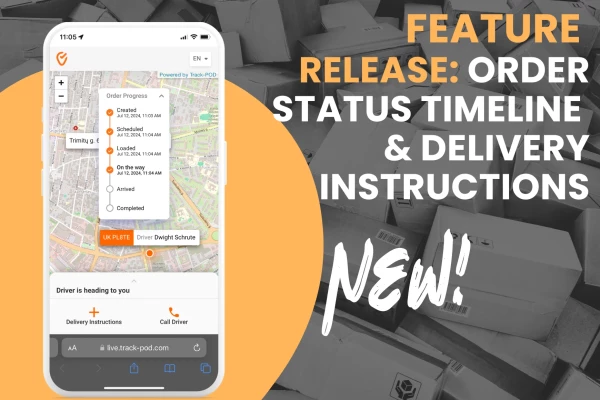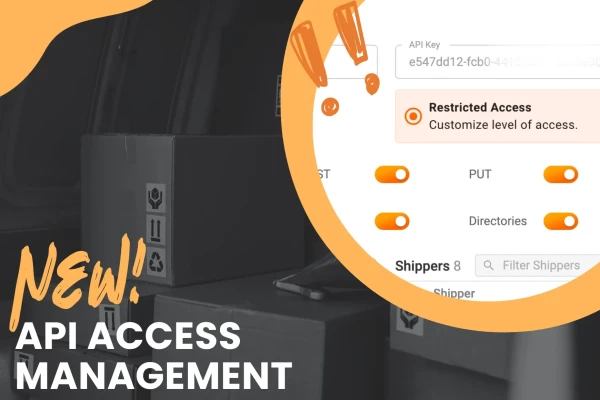How Shipment Analytics Helps Route Optimization

by
Yulia Miashkova
July 15, 2021
There is no questioning the kind of influence data and analytics have on logistics, shipment route optimization, and management in 2022.
Big data has inched its way into almost all spheres of our lives, professional and personal. In the case of shipment and transport management, this evolution of data and analytics technology has been for the better.
In this article, we will take a look at the role of analytics in shipment route optimization, the benefits of using analytics, and practical examples of the data technology in action.
How analytics feature in route planning and shipment route software
You’ve probably heard of and even used analytics. The term is prevalent on digital platforms, applications, and software systems. Anybody who has a social media account knows a bit about analytics and metric systems. For route planning and shipment optimization software, analytics work pretty much in the same way.
You can collect data and statistics using digital touchpoints in your route management process. And if you’re asking yourself if you even have any touchpoints, the answer is yes, absolutely!
Digital touchpoints that have the potential for data gathering and analytics include inventory software or order management platforms, vehicle trackers, digital apps used in your transportation process, and more. All of these have the potential to record and store data that you can use later on.
With route planning and optimization software, you can centralize data collection and analysis using one platform. Let’s see how.
How does analytics help with shipment route optimization?
Understanding the pervasiveness of data in transport management helps illustrate the great potential that analytics have in improving shipment route optimization processes. In the past, route optimization was a tedious process involving hours of employee time spent on analyzing the pros and cons of using different routes.
With data technology, you can simplify the shipment route optimization process and make it more accurate. Route and fleet managers can pull data from an array of sources like vehicles, active drivers, trackers, sensors, scanners, real-time traffic updates, weather reports, and more.
Through the web-like connectivity of the Internet of Things (IoT) and the integration of other technologies like artificial intelligence and machine learning, analytics can optimize routes better than ever before.
Insights and data gathered through one or more of the above methods can help with many things.
-
Route planning.
-
Route optimization.
-
Updating routes in real-time.
-
Supply chain management.
-
Scheduling.
-
Delivering time-sensitive goods.
-
Improving customer service.
These are just some of the ways in which data and analytics can help with route optimization.
Pros of using analytics for route management & supply chain
Using analytics can have fantastic benefits for various areas of your fleet management including your shipment route management. The use of predictive and advanced analytics allows your business to reap the following benefits for the improvement of your operations.
Forecasting
Forecasting and the use of analytics for predictive planning is one of the great benefits of big data developments in recent years. While it is possible for human beings to note trends in behavior and customer purchases, forecasting technology and data take this process to a whole new level.
With forecasting and predictive analytics systems, your organization can get insight into future supply and demand patterns. This allows you to better plan your inventory levels, shipments, and shipment routes for scheduled inventory top-ups.
The better foresight this provides also gives you a nuanced understanding of customer demand, purchase behavior, and preferences. This enables smarter and more informed decision-making, inventory and warehouse management, shipment scheduling, waste management, and order fulfillment as such.

Maintenance
Not only can analytics and data help you better prepare and manage your inventory levels, but they can also guide decision-making around equipment maintenance and fleet maintenance.
Drawing data from different tech systems or software solutions like your shipment route planner’s internal vehicle tracking helps you determine when vehicles in your fleet need maintenance or service. You can monitor distance traveled and track any issues reported about a vehicle to help you schedule maintenance checks more effectively.
Some companies also use predictive artificial intelligence to identify patterns in defective or failed equipment. This same technology can also point to anomalous machine behavior. You can use this data to address equipment issues and pre-empt the same issues in the future, dealing with them before the problem arises. Overall, this improves productivity and the efficiency of your supply chain.
Transportation management
Transport management systems (TMS) help transport managers and other transportation team members deal with transport operations. Predictive analytics enhance the capabilities of TMS systems, anticipating issues before they occur and improving the general supervision of transportation operations.
Risk management
Transportation operations and shipment routes are very sensitive elements to manage as plans can change on the fly. There are a variety of factors that can take a shipment status from on-time to late or delayed.
Analytics helps better deal with the unexpected circumstances and risks surrounding shipment routing. An analytics system can observe weather conditions, traffic patterns, shortages, and other factors. It can then use its analysis to adjust shipment routes to provide sensible, quicker, and shorter options. Overall, this reduces risks, uncertainties, and delays in shipment deliveries.
Supply chain visibility
It can get tricky to oversee the movement or management of shipments or packages from location to location. The ability to see these movements promotes better monitoring of your shipment processes. According to Transport Topics’ research, predictive analytics is an efficient way to promote visibility in your supply chain.
You can reduce the number of delayed or late shipments through monitoring and tracking devices, which has a direct impact on the costs incurred for late or delayed shipments. Through improved visibility, it becomes easier to pinpoint the location and state of the shipment and adjust shipment routes accordingly.
Not only are the above some of the benefits your logistics organization can gain from using analytics, but they are also practical examples of analytics in action as many deliveries, shipments, and other transport-based companies use analytics in these ways.
Cons of using analytics for shipment route management & supply chain
Of course, as with any aspect of business, there are some disadvantages to consider when thinking of using data analytics.
Predictive limitations
Data can help predict a number of different things but there is no way to pinpoint how humans may react on a specific day. Human beings affect the effectiveness of your shipment routing. For example, a driver’s misunderstanding of provided navigation instructions for a shipment route can lead to delays in delivery.
Although analytics cannot account for human behavior entirely, you can use it to estimate and account for human behavior that can affect your shipment routes and shipment deliveries. This would be based on previously recorded data.
Data bias
Data collection and data analysis has the potential for bias. Different departments may demonstrate a bias towards collecting and observing particular types of data. Ignoring other data sets can prevent them from learning and improving more efficiently. Although automated systems that can ease the bias inherent in data collection and analysis do exist, there are few systems that can implement decisions based on this data.
You can also avoid and decrease biases in data by asking diverse questions, collecting data from different sources, and getting input from different members of the department.
Inaccuracy
Of course, there is no fool-proof way to remove all uncertainty from your shipment route operations. Uncertainty and discomfort around the effectiveness of data can cause businesses to second-guess the value of utilizing analytics. Doubt in this way can cause managers to make decisions that oppose the data presented as they believe it is incorrect.
Inaccuracy and uncertainty can also be a consequence of poor data collection, analysis, and management. An accurate data strategy is vital for being able to use the data for the benefit rather than the detriment of the business. You need to be able to trust the data you use.
Analytics use cases
If you are trying to envision how you can use analytics and data for your organization, you can look at these companies’ methods of using the technology. There are great possibilities for what analytics can do for your business and how you can utilize them to improve your business. To develop the best data strategy, you should do some research and learn from other businesses.
DHL
In 2018, DHL Supply Chain committed to investing over $300 million in the use of emerging tech systems for their locations across the world. This included their supply visibility platform, MySupplyChain, which uses analytics for supply chain optimization and visibility of the logistics giant’s global operations.
Amazon
Amazon is known for its personalized customer experience and shipping offers. Amazon provides personalized recommendations and shipping predictions for their customers based on their previous purchases, buying habits, and other factors. This is also based on popular purchases in their area, which guides their stocking and inventory decisions for warehouses in that area. Amazon uses this data to allocate drivers, determine shipment routes, and meet customer needs and demands more efficiently.
UPS
UPS spends approximately one billion dollars on technological solutions per year, including predictive analytics. They use predictive analytics to meet evolving customer needs for swift order delivery and the optimization and efficiency of their operations. UPS developed an artificial intelligence and machine learning and advanced analytics platform, Network Planning Tools (NPT), to enhance their visibility of global UPS facilities and shipment routes.
Through the tool, the system uses data details like package weight, volume, costs, customer satisfaction, and more for forecasting and better deliveries.
Maersk Line
Maersk Line has adjusted its operations to embrace the use of predictive analytics and data. In particular, Maersk, which is the largest shipping entity in the world, has focused on using analytics to improve visibility to avoid waste. They better manage the distribution and use of their containers in the 130+ countries that they work in.
Track-POD
Track-POD offers a diverse range of software solutions to help businesses navigate shipment operations. Supported by data from different sources including drivers’ smartphone applications, sensors, scanners, and other components, Track-POD gives businesses clear insight into their transportation activities.
Track-POD makes utilizing analytics easy for your business. You can access data and analytics easily on the platform or the connected cloud database.
The solutions also adjust data in real-time, using live analytics and insights to adjust shipment routes. Track-POD collects varying data sets including driver and vehicle data, collating the information into easy analysis reports that can be used for shipment route improvement.
Overall, Track-POD’s systems, solutions, and features support and utilize analytics to assist transportation companies with seamless deliveries and shipment route optimization.

Conclusion
Analytics plays an important role in transportation management as it gives insight into processes that might be invisible otherwise. For logistics and supply chain management, analytics contributes to improving efficiency, productivity, and enhancing operations for the overall optimization of your business.
Although the use of data and analytics has its potential downsides, it is evident that it presents tremendous potential for growing and improving your business. Benefits including forecasting, risk management, better decision-making, and improved management of systems, contribute to the performance of your organization. Beyond that, it also helps you meet the needs and demands of your customers.
Certainly, the possibilities of analytics far surpass what can be done by human beings alone. It may seem like an uncertain and scary direction – particularly if your business has not ventured into extreme digitalization. However, the benefits are absolutely worth it, right now and for the future.
About The Author
Yulia Miashkova
Growth marketing manager with a background in public relations, SEO, social listening, and Account-Based Marketing.







